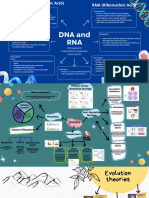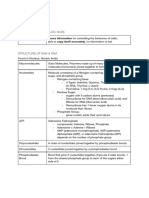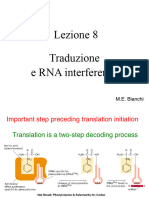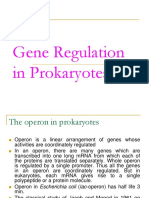8c) Transcription Summary - 9744 - 2018
8c) Transcription Summary - 9744 - 2018
Uploaded by
2022 EMMA WEN XUAN HANSONCopyright:
Available Formats
8c) Transcription Summary - 9744 - 2018
8c) Transcription Summary - 9744 - 2018
Uploaded by
2022 EMMA WEN XUAN HANSONOriginal Title
Copyright
Available Formats
Share this document
Did you find this document useful?
Is this content inappropriate?
Copyright:
Available Formats
8c) Transcription Summary - 9744 - 2018
8c) Transcription Summary - 9744 - 2018
Uploaded by
2022 EMMA WEN XUAN HANSONCopyright:
Available Formats
Genetics and Inheritance (9744) DNA & Genomics (Transcription) 2018
TRANSCRIPTION. :the synthesis of RNA using a DNA template Promoter Transcription Unit Termination sequence
3 main components of a gene
(occurs in nucleus)
IN EUKARYOTES IN PROKARYOTES
INITIATION INITIATION
general transcription
1. RNA polymerase is a multimeric complex. factors
1. RNA polymerase is a multimeric (made up of many subunits) complex.
2. General transcription factors first assemble along 2. Sigma factor associates with core RNA polymerase forming the RNA
the promoter. polymerase holoenzyme
3. General transcription factors recruit RNA polymerase 3. As the holoenzyme scans along the DNA, its sigma factor recognizes
& position it correctly on the promoter. and binds to the promoter.
promoter
4. The complex of RNA polymerase and transcription 4. RNA polymerase
factors is called the transcription initiation complex. unzips the 2 strands of the
5. RNA polymerase unzips the 2 strands DNA double helix at
of the DNA double helix at promoter by breaking promoter by breaking
hydrogen bonds between base pairs. hydrogen bonds between
6. Only one strand is used as the template to synthesise the base pairs.
mRNA. 5. Only one strand is used as
(N.B. The template strand is also the non-coding strand) a template to synthesise mRNA.
IN EUKARYOTES AND PROKARYOTES
ELONGATION
1. Free ribonucleotides match up with the template DNA strand by complementary base pairing.
2. Cytosine base pairs with guanine, guanine base pairs with cytosine, thymine base pairs with adenine & adenine base pairs with uracil. mRNA
3. RNA polymerase catalyses the formation of covalent phosphodiester bonds between adjacent ribonucleotides. transcript
4. As each ribonucleoside triphosphate is brought in, 2 of its terminal phosphate groups are removed and the 5’ end of the resulting
ribonucleotide is added to the 3’ end of the growing RNA strand via the formation of a phosphodiester bond.
5. Thus the mRNA strand is synthesized & elongated in the 5’ to 3’ direction & the template DNA strand is read in the 3’ to 5’direction.
6. As the transcription complex continues to move down the DNA double helix, unzipping the 2 strands, and synthesizing mRNA, the
region of DNA that has just been transcribed, reanneals.
mRNA transcript
IN EUKARYOTES IN PROKARYOTES
TERMINATION TERMINATION
1. RNA polymerase transcribes a sequence on the DNA, which codes for a polyadenylation signal (AAUAAA) in hairpin loop
1. After transcribing through a
the pre-mRNA. termination sequence (in DNA), RNA
mRNA
2. Proteins (endonucleases) bind at a point (10 to 35 nucleotides) downstream of the polyadenylation signal to cut the transcribed terminator
and free the pre-mRNA from the polymerase. (an mRNA sequence) folds back
polyadenylation signal free pre-mRNA to form a hairpin loop. DNA
CUT 2. The loop acts as a termination signal
Pre-mRNA 5’________________AAUAAA_____________3’ 5’________________AAUAAA__3’ that causes the mRNA and RNA
polymerase to be released.
POST-TRANSCRIPTIONAL MODIFICATION (Only in EUKARYOTES)
1. Addition of methylguanosine cap to 5’ end of pre-mRNA
the 5’ cap protects mRNA from degradation by ribonucleases that degrade RNA form the 5’end, serves as
a recognition signal for the small ribosomal subunit to assemble & begin translation & facilitates the export of mature
mRNA form the nucleus) 5’ cap added, introns excised &
2. RNA splicing (which requires ATP) by spliceosomes which excise introns(non-coding seq.) & join exons(coding seq). exons joined, poly A tail added
3. Synthesis of poly A tail (polyadenylation) by the enzyme poly A polymerase which adds adenine nucleotides downstream
of polyadenylation sequence, AAUAAA.
protects mRNA from degradation by ribonucleases, making it a more stable template for translation and directs the export
of mRNA through nuclear pores into the cytoplasm.
Prepared by: Mrs Selvamani Nair Raffles Institution (Yr 5-6) 5
You might also like
- Types of RNA-Worksheet Omar IbrahimDocument5 pagesTypes of RNA-Worksheet Omar IbrahimOmar Ibrahim LNo ratings yet
- Gene Expression - Protein SynthesisDocument39 pagesGene Expression - Protein SynthesisTawonga ManjiniNo ratings yet
- CH 16 and 17 Worksheet-1Document3 pagesCH 16 and 17 Worksheet-1Dani Jo OwensNo ratings yet
- The Central Dogma of Molecular BiologyDocument4 pagesThe Central Dogma of Molecular BiologyJoshuaMondejarNo ratings yet
- Gene ExpressionDocument26 pagesGene Expressionceline.ayoNo ratings yet
- Polypeptide Synthesis: TranscriptionDocument3 pagesPolypeptide Synthesis: TranscriptionliklyNo ratings yet
- Biochem-Lec TransesDocument9 pagesBiochem-Lec TransesK CruzNo ratings yet
- Dna Replication and Protein SynthesisDocument9 pagesDna Replication and Protein Synthesisbravebrave2005No ratings yet
- PROTEIN SynthesisDocument37 pagesPROTEIN SynthesisChirag Kothari100% (1)
- Protein Synthesis - DNA Transcription and Translation-2Document51 pagesProtein Synthesis - DNA Transcription and Translation-2limshinyen22No ratings yet
- Key Notes Genetic Material and Central DogmaDocument2 pagesKey Notes Genetic Material and Central DogmaSeiza WinchesterNo ratings yet
- Transcription and Translation NarrativeDocument3 pagesTranscription and Translation NarrativeBridget Anne BenitezNo ratings yet
- Gene ExpressionDocument46 pagesGene Expressionmohammed mahmoudNo ratings yet
- Class 12 - Genetics NotesDocument1 pageClass 12 - Genetics NotesDimas HernadyNo ratings yet
- Lecture 13 Genes and How They WorkDocument31 pagesLecture 13 Genes and How They WorkPaulNo ratings yet
- Lesson 3A - RNA Types and StructuresDocument3 pagesLesson 3A - RNA Types and Structureshannah CorpuzNo ratings yet
- Replication and Transciption of DnaDocument29 pagesReplication and Transciption of DnaTri Hiu AmborowatiNo ratings yet
- GeneticsDocument3 pagesGeneticsbonoo.santuchoNo ratings yet
- UNIT 3 - TranscriptionDocument1 pageUNIT 3 - TranscriptionMuralidharan MNo ratings yet
- Nucleic Acids + Protein SynthesisDocument5 pagesNucleic Acids + Protein SynthesisNezza WidarkoNo ratings yet
- IB Diploma Biology: Essential Idea: Transcription and Translation Allow The GeneticDocument37 pagesIB Diploma Biology: Essential Idea: Transcription and Translation Allow The GeneticClàudia VicenteNo ratings yet
- DNA Translation and Transcription PDFDocument2 pagesDNA Translation and Transcription PDFSim QuiambaoNo ratings yet
- Ilovepdf MergedDocument4 pagesIlovepdf Mergedakmal nazrinNo ratings yet
- HvhyvugvDocument35 pagesHvhyvugvahanasauNo ratings yet
- Lecture 4 - Mechanism of Transcription in BacteriaDocument51 pagesLecture 4 - Mechanism of Transcription in BacteriaBakalJenazahNo ratings yet
- Lesson 0-1Document10 pagesLesson 0-1Francesca YanzonNo ratings yet
- DNA Replication and Protein SynthesisDocument2 pagesDNA Replication and Protein SynthesislibbyNo ratings yet
- Lesson 0Document6 pagesLesson 0Francesca YanzonNo ratings yet
- Lez08 Traduz RnaDocument47 pagesLez08 Traduz RnaMaria HuNo ratings yet
- GENELEC - Module 7Document4 pagesGENELEC - Module 7raveenaperaltaNo ratings yet
- ASS 7 (bbt193003) MGDocument7 pagesASS 7 (bbt193003) MGAbuzar KhanNo ratings yet
- M.I.T LessonsDocument12 pagesM.I.T LessonsChassy KammyNo ratings yet
- Bio Keypoints ReviewerDocument4 pagesBio Keypoints ReviewerFrancisNo ratings yet
- ReviewerDocument7 pagesReviewerFrancesca YanzonNo ratings yet
- Miniature Protein BIologyDocument83 pagesMiniature Protein BIologyPREET KANOOGANo ratings yet
- Transcription Study GuideDocument5 pagesTranscription Study GuideSubhajit AdakNo ratings yet
- Dna Replication PDFDocument6 pagesDna Replication PDFCarpioNo ratings yet
- S2. Transcription Translation Gene RegulationDocument87 pagesS2. Transcription Translation Gene RegulationDeriq Maorenz CruzNo ratings yet
- Harper S Illustrated Biochemistry by Vic-385-403Document19 pagesHarper S Illustrated Biochemistry by Vic-385-403DavidNo ratings yet
- DNADocument64 pagesDNAsapphireriego01No ratings yet
- DNA Kita Iiwan RNA CytoDocument3 pagesDNA Kita Iiwan RNA CytozairahNo ratings yet
- Chapter 17 - Transcription and TranslationDocument14 pagesChapter 17 - Transcription and TranslationAdonias NiyurukundoNo ratings yet
- TranscriptionDocument31 pagesTranscriptionDeeptanshu PrakashNo ratings yet
- Sci Q3 Protein Synthesis and MutationDocument7 pagesSci Q3 Protein Synthesis and MutationMel GonzalesNo ratings yet
- Biology Lesson 1.1Document16 pagesBiology Lesson 1.1Crystal Joy BondadNo ratings yet
- RNAiDocument36 pagesRNAiCT Bảo NgọcNo ratings yet
- L9 BIO Central DogmaDocument22 pagesL9 BIO Central DogmaTHE SAS WAYNo ratings yet
- 2020 RNA Synthesis, Processing, HandoutDocument22 pages2020 RNA Synthesis, Processing, HandoutDarkamou D.YarkpawoloNo ratings yet
- Protein SynthesisDocument8 pagesProtein SynthesisDebbie NsefikNo ratings yet
- Transcription and TranslationDocument8 pagesTranscription and Translationgwentoledo33No ratings yet
- Compre MolbioDocument93 pagesCompre MolbioDeniebev'z OrillosNo ratings yet
- TranscriptionDocument15 pagesTranscriptioncamila hartmannNo ratings yet
- 4.9 Cell Division & Protein SynthesisDocument21 pages4.9 Cell Division & Protein Synthesis2023875802No ratings yet
- 3rd Week (1) - TrancriptionDocument46 pages3rd Week (1) - TrancriptionyazicigaamzeNo ratings yet
- Transcription and TranslationDocument35 pagesTranscription and TranslationMing mingNo ratings yet
- TranscriptionDocument21 pagesTranscriptionlatenightNo ratings yet
- BIO-5dll 3rdDocument15 pagesBIO-5dll 3rdarlene dioknoNo ratings yet
- What IsDocument17 pagesWhat Islunaichiro24No ratings yet
- 4.9 Cell Division & Protein SynthesisDocument19 pages4.9 Cell Division & Protein Synthesiseliesezlynn12No ratings yet
- 8a) DNA and Genomics Table - 9744 - 2018Document3 pages8a) DNA and Genomics Table - 9744 - 20182022 EMMA WEN XUAN HANSONNo ratings yet
- 8b) DNA Replication Summary - 9744 - 2018Document1 page8b) DNA Replication Summary - 9744 - 20182022 EMMA WEN XUAN HANSONNo ratings yet
- 7) Mitosis and Meiosis Summary 9744 - 2018Document3 pages7) Mitosis and Meiosis Summary 9744 - 20182022 EMMA WEN XUAN HANSONNo ratings yet
- 8d) Translation Summary - 9744 - 2018Document1 page8d) Translation Summary - 9744 - 20182022 EMMA WEN XUAN HANSONNo ratings yet
- Bm7 RemodellingDocument105 pagesBm7 RemodellingabdullahshiddiqadamNo ratings yet
- IGA 10e SM Chapter 08Document12 pagesIGA 10e SM Chapter 08Muneeb ArshadNo ratings yet
- Gene PredictionDocument50 pagesGene Predictionsaeedahmad901No ratings yet
- Cell Biology: InstructorDocument20 pagesCell Biology: Instructorahmed mediaNo ratings yet
- Lac Operon - Genetics-Essentials-Concepts-and-ConnectionsDocument15 pagesLac Operon - Genetics-Essentials-Concepts-and-ConnectionsDiandra AnnisaNo ratings yet
- Dna Structure PDFDocument106 pagesDna Structure PDFAbd ahmadNo ratings yet
- Reporter Genes and TrapsDocument2 pagesReporter Genes and TrapsAmit KumarNo ratings yet
- Sys Bio TextDocument25 pagesSys Bio TextAlpahNo ratings yet
- Gene Regulation in Prokaryotes-1Document17 pagesGene Regulation in Prokaryotes-1Fasiha Mushadi100% (1)
- Chapter Fourteen: RNA Molecules and RNA Processing: Comprehension Questions Section 14.1Document11 pagesChapter Fourteen: RNA Molecules and RNA Processing: Comprehension Questions Section 14.1Qayyum LatipNo ratings yet
- CarcinogenesisDocument3 pagesCarcinogenesiskishorkumarn8212No ratings yet
- 221 Final Exam Answer KeyDocument14 pages221 Final Exam Answer KeyGizem OsmanogluNo ratings yet
- WWW - Itescam.edu - MX Principal Sylabus FPDB Recursos r72057Document5 pagesWWW - Itescam.edu - MX Principal Sylabus FPDB Recursos r72057Singh AnujNo ratings yet
- Chan Et Al 2015 (Biocontainment 01)Document7 pagesChan Et Al 2015 (Biocontainment 01)Felix Moronta BarriosNo ratings yet
- 1597 Vir000487Document7 pages1597 Vir000487Milan PetrikNo ratings yet
- 28Document39 pages28IqbalullohNo ratings yet
- Machine Learning in Genomics MedicineDocument22 pagesMachine Learning in Genomics MedicinesuruchiNo ratings yet
- Gene ExpressionDocument7 pagesGene ExpressionTom Anthony TonguiaNo ratings yet
- Paper 1: Multiple Choice (MARK SCHEME) : St. Andrew'S Junior College 2018 Jc2 PrelimsDocument21 pagesPaper 1: Multiple Choice (MARK SCHEME) : St. Andrew'S Junior College 2018 Jc2 PrelimsWeiyu XuNo ratings yet
- DNA Replication Transcription and TranslationDocument49 pagesDNA Replication Transcription and TranslationKhaled DabourNo ratings yet
- Gene Expression in ProkaryotesDocument43 pagesGene Expression in ProkaryotesravibiriNo ratings yet
- Krol SciAdv 2019 PDFDocument9 pagesKrol SciAdv 2019 PDFFranciscoNo ratings yet
- Eukaryotic and Prokaryotic Gene StructureDocument5 pagesEukaryotic and Prokaryotic Gene Structuredaniel murilloNo ratings yet
- Transcription and Translation by Dr. Mesut KarahanDocument26 pagesTranscription and Translation by Dr. Mesut KarahanEmily ClementhNo ratings yet
- Chapter 6 XamideaDocument64 pagesChapter 6 Xamideakeren spamzNo ratings yet
- 9BN0 02 Rms 20180815Document30 pages9BN0 02 Rms 20180815GershonNo ratings yet
- The Role of Epigenetics in Accelerated Aging: A Reconsideration of Later-Life Visual Loss After Early Optic NeuropathyDocument7 pagesThe Role of Epigenetics in Accelerated Aging: A Reconsideration of Later-Life Visual Loss After Early Optic Neuropathygerardo davidNo ratings yet
- Transcription and TranslationDocument2 pagesTranscription and TranslationMary Rose Bobis VicenteNo ratings yet
- Chap. 7 Transcriptional Control of Gene Expression: (Part A)Document8 pagesChap. 7 Transcriptional Control of Gene Expression: (Part A)Shivesh SharmaNo ratings yet
- Peter J. Barnes - Tobacco DocumentsDocument55 pagesPeter J. Barnes - Tobacco DocumentsDavid LeloupNo ratings yet





























































































